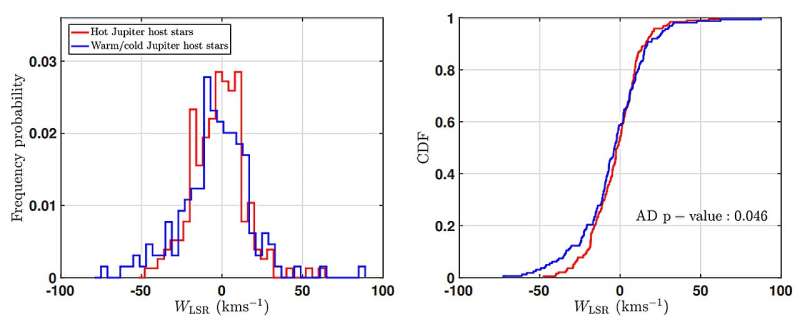November 3, 2023 report
This article has been reviewed according to Science X's editorial process and policies. Editors have highlighted the following attributes while ensuring the content's credibility:
fact-checked
peer-reviewed publication
trusted source
proofread
Link found between age of stars and frequency of hot Jupiters

A team of astronomers and astrophysicists affiliated with several institutions in China, working with one colleague from Centro Ricerche Enrico Fermi, in Italy, and another from the University of Utah, in the U.S., has found a link between star age and the frequency of hot Jupiters. In their study, reported in Proceedings of the National Academy of Sciences, the group characterized the ages of a large number of star systems that have Jupiter-like exoplanets and compared them.
In this new effort, the research team sought to learn more about star systems that host Jupiter-size exoplanets. More specifically, they wanted to know if the age of a star system might be related to its likelihood of hosting Jupiter-sized planets that have an orbital period of less than 10 days. Such exoplanets have come to be known as hot Jupiter exoplanets because they tend to orbit their stars closely.
Prior research has suggested that such exoplanets are hotter than others of similar makeup due to the heat they receive from their star. Such exoplanets also have much stronger winds due to the extreme temperature differences between the night and day sides of the planet.
To learn more about the association of hot Jupiters and star age, the researchers collected and analyzed data for 383 Jupiter-sized planets that orbit stars that are similar in size and characteristics to the sun. They found that hot Jupiters were more likely to be found orbiting relatively young stars. They also found that the number of hot Jupiter exoplanets declines as star systems grew older. They also noted that they found no similar correlations between cold or warm Jupiters.
The research team also found that the frequency of finding hot Jupiters reduced as their orbits decayed, likely due to a tidal impact. Such decays, it has been suggested, likely lead to planet death. They found that the frequency of hot Jupiters was proportional to the amount of metal in the host star, a finding that helps to explain discrepancies between the number of hot Jupiters that have been found as calculated using planetary transit versus exoplanet surveys based on radial velocity.
More information: Di-Chang Chen et al, The evolution of hot Jupiters revealed by the age distribution of their host stars, Proceedings of the National Academy of Sciences (2023). DOI: 10.1073/pnas.2304179120
Journal information: Proceedings of the National Academy of Sciences
© 2023 Science X Network




















